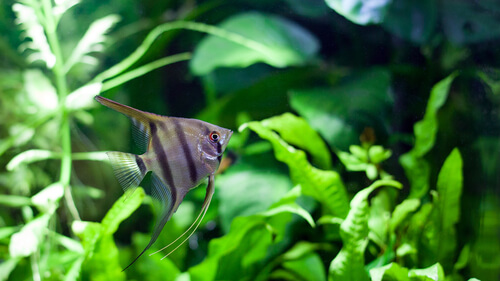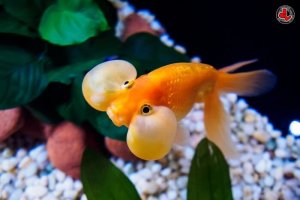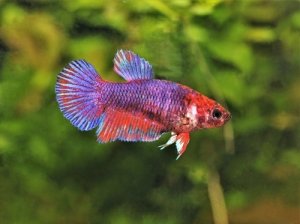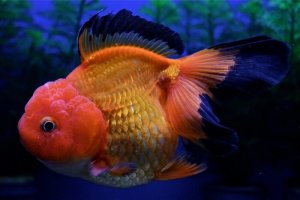Breed Overview
| Origin | Orinoco river headwaters |
| Lifespan | 10-15 years |
| Size | 6-12” (15-30 cm) |
| Colour | White with dark grey/Black stripes |
| Food | Omnivorous |
| Tank Size | Minimum 55 gallons/208 liters |
| Temperament | Semi-aggressive, social, hierarchical |
| Water Type | Freshwater |
| Water Temperature | 74-82F/23-28C |
| Water pH | 5-7.5 |
| Difficulty Level | Intermediate |
Species Summary
Freshwater angelfish species like the altum angelfish are actually a type of cichlid. This means that despite their delicate appearance, they are actually related to other chichlids like the whopping Oscar fish! However, the looks of these guys developed to match their habitats in Brazil and Venezuela, where their flattened bodies allowed them to hide amongst submerged wood and plants. Whilst other angelfish species come from the headwaters of the Amazon, river, the altum angelfish comes from tributaries of the Orinoco.
Altum angelfish are territorial and hierarchal, showing complex social behavior and distinct personalities. This makes them extremely interesting to have in a tank as it is a delight to watch how they all differ from each other.
Tank Setup For Altum Angelfish
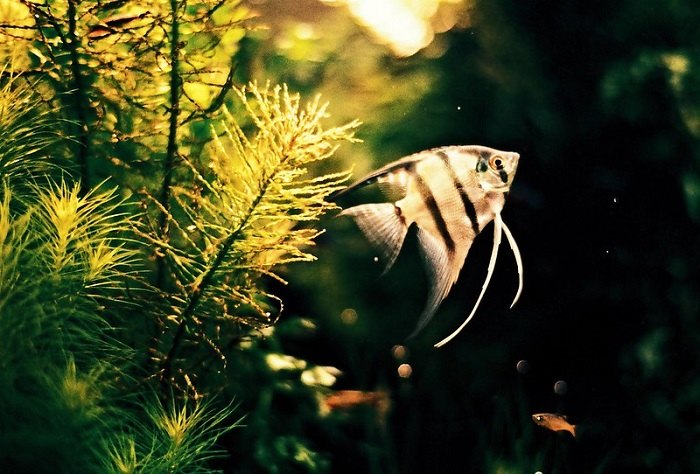
So, How Big Do Angelfish Get? If you are asking ‘How big do angelfish get?’, it’s important to take into account both their height and their length. Unlike fish such as goldfish, the unusual shape of angelfish means that tank height is also really important.
Angelfish tend to reach 8 inches (20 cm) in height and 6 inches (16 cm) in length. In fact, altum angelfish are actually some of the biggest angelfish and tend to easily reach this full height.
It’s generally a good idea to have a tank that is longer than it is tall, so your fish can swim freely up and down. However, a sufficient amount of height is also important, ideally, double your fish’s maximum possible height.
Water parameters and specifications
| Ideal Size | Minimum 55 gallons for a pair with an additional 10-15 gallons per extra fish |
| Suitable Substrates | Gravel or sand with aquarium soil underneath to allow plants to take root |
| Filtration systems | Flow rate of 5-10x tank size |
| Ammonia and nitrites | 0 |
| pH level | 5.8-6.8 |
| Temperature | 82-90 F/ 26-29 C |
| Lighting | LED |
What Size Tank Do Freshwater Angelfish Need?
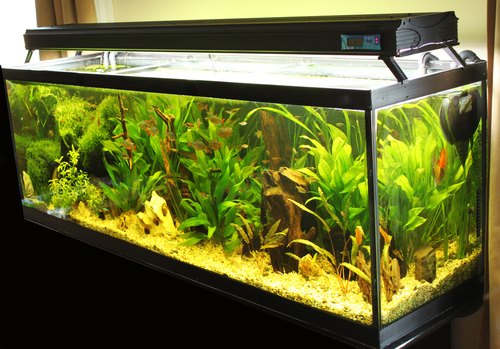
A minimum of 55 gallons is recommended for a community tank. However, if you want to keep things on the safe side, you can set up this type of tank for a single pair and then add an additional 10-15 gallons per extra fish depending on your space and resources. This is because as they are territorial, angelfish will prefer a larger tank so they can minimise competition.
Tank Maintenance
Like other species of angelfish is the genus pterophyllum, altum angelfish have a social hierarchy that is in fact communicated by scent and pheromones within the water. As a result of this, some fishkeepers have found that frequent water changes can increase aggression, as removing the pheromones prompts your fish to re-establish the pecking order.
It was found that less frequent water changes decreased aggression in the closely related pterophyllum scalare, and your altum angelfish will also benefit from you leaving the water as is slightly longer than you might be tempted. The ideal duration is anywhere between 1 and 3 weeks depending on your tank size, as larger tanks with lower density will need a less frequent water change.
Setting Up A Community Tank
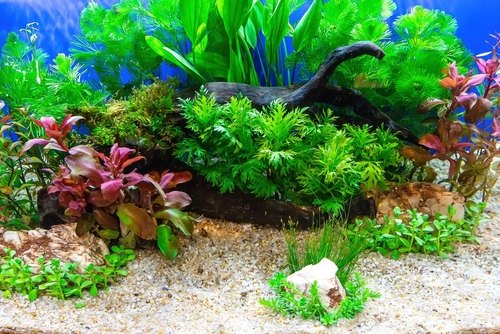
The two things that make wild caught angelfish like the altum angelfish or Leopold’s angelfish stand out even from the more commonly seen pterophyllum scalare is their need for soft, acidic water, and a warm temperature as listed in the parameters section above.
If your water is too hard, you can fortunately use a CO2 injector to lower both water hardness and pH until it is at it’s optimum. Another natural way for maintaining these conditions is the use of tannin-heavy driftwood. This is because altum angelfish live in riverine environments that are naturally saturated with organic matter from fallen logs, leaf matter, and decaying vegetation from the surrounding rainforest. By introducing driftwood into your tank, tannins leach into the water and help mimic these conditions.
Author’s Note: You may have heard that angelfish can be aggressive. However, fish aggression tends to depend on a variety of factors and isn’t set in stone. Stress will make your fish more aggression, but tank setup also has a huge influence. The larger and more varied the tank, and the lower the tank density, the better chance you have of reducing aggression.
1. Arranging Plants And Decoration:
As angelfish like to hide amongst plants and decoration, it’s a good idea to keep this in mind when setting up your tank. Plant aquatic plants in drifts and create tunnel arches and corridors with plants, stones, and driftwood to minimise stress.
2. Appearance Of Altum Angelfish
If you have not kept them before, you may be struck by the number of colors of freshwater angelfish. In fact, most of these are selectively bred variants of a different species, pterophyllum scalare. The altum angelfish is generally wild caught and comes in one color, that is, a pattern of clear/white/pearly scales with dark black or charcoal grey stripes. However, these fish nevertheless look very striking and are great for a minimalistic tank.
- Availability Of Altum Angelfish In Pet Stores:
Most good sized aquatics stores should stock altum angelfish. However, as this is a wild caught species, availability is not as stable as with the captive bred pterophyllum scalare. If you can’t find any in your local pet store, you can look online for a dealer, but just be sure to research them first!
Best Tankmates For Altum Angelfish
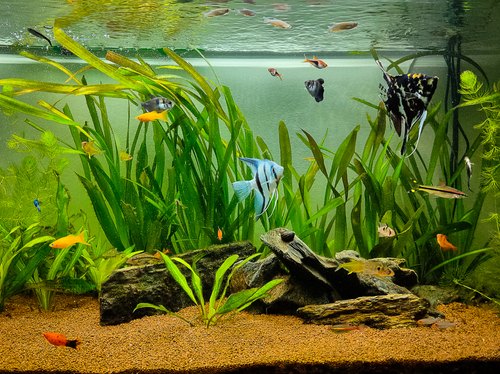
Now you have your tank set up, it’s time to think about some angelfish tankmates! As altum angelfish have long flowing fins, it’s best to avoid fin nipping or aggressive fish. The following fish are all a safe bet for an angelfish tank:
- Neon tetra
- Rummynose tetra
- Congo tetra
- Epistogramma cichlid
- Electric blue ram
- Cory catfish
- Zebra loaches
- Gouramis
- Zebra danios
Never mix shrimps and snails with your angelfish! Your fish will very likely see these small invertebrates as food and quickly gobble them up.
Author’s Note: This article covers smaller tankmates intended for a tank that mainly contains angelfish. However, did you know angelfish also get on well with discus fish? Both are part of the cichlid family and can be fed the same food. In addition, colorful discus and black and white angelfish make a striking contrast!
Behavior And Temperament
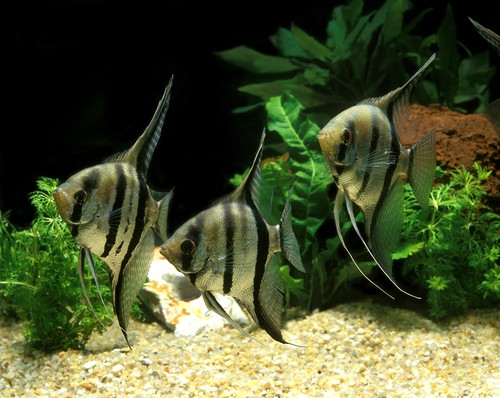
One of the reasons many aquarists love angelfish is because they all have unique personalities and interact with their environment a lot. Simply put. The more you observe these fish, the more they will reveal to you! However, this also means that their behavior is strongly affected by their environment. For example, higher temperatures can increase competition.
Angelfish are known for having preferences. Some are shyer and prefer hanging around in aquatic plants, whereas some are bolder and prefer free swimming. Some enjoy feeding at the top of the tank, and some at the bottom. They even have different food preferences!
Feeding Altum Angelfish
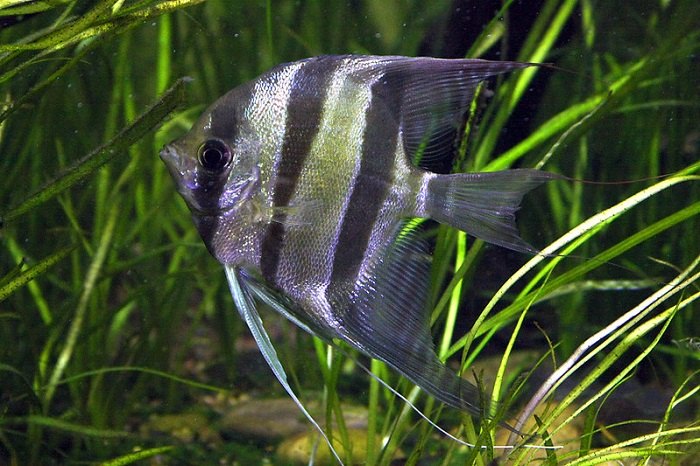
The safest way to feed your altum angelfish is by starting with a pellet based cichlid food, which is also formulated for discus fish and can work for tankmates such as ram cichlids.
However, it’s best to enrich your fish’s diet, which you can do with the following food once or twice a week:
Protein:
- Brine shrimps
- Tubifex worms
- Bloodworms
- Daphnia
Vegetable Matter:
- Lettuce
- Broccoli
- Half a shelled pea
- Duckweed
What To Do If Your Angelfish Is Not Eating
If your angelfish is not eating, this can be for a variety of reasons. Although they are omnivorous, they do prefer a bit more protein and it might be that they are fed up with their food. In this case, you can try other proteins like black soldier fly larvae (and adult flies) as well as fruit flies, chopped earthworms, and bean beatles and larvae. However, it’s always important to rule out other factors like stress, illness, or your angelfish carrying eggs.
Pests And Diseases
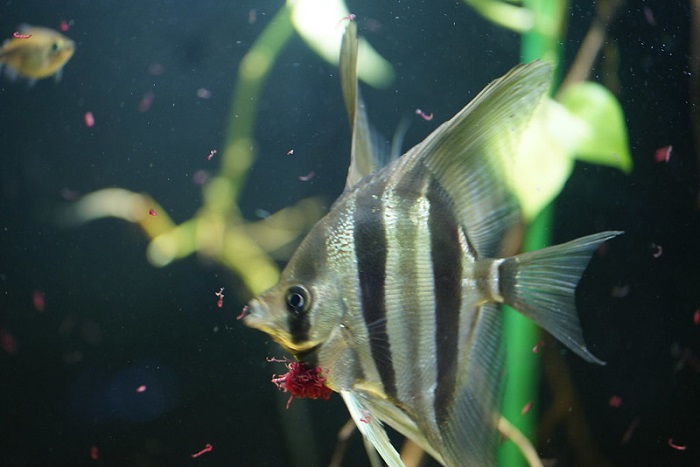
1. Ich
Ich, or white spot disease, is common in many freshwater fish and likewise can also affect your altum angelfish. It is a small parasite and one of the first signs that your fish is infected is behavioral changes, including lethargy. It can generally be treated by isolating the fish and giving specialist over the counter medication.
2. Color Change
You may occasionally see your angelfish change its’ color, with stripes fading and reappearing. This can be alarming, and you may wonder if your fish has a disease.
Your fish losing it’s stripes can be a sign of general stress, as maintaining stripes takes energy. Therefore, to conserve energy to manage poor water conditions, your fish may actually lose it’s patterning. It can also be a sign of more serious diseases.
3. Bacterial Infections
Bacterial infections generally stem from poor water conditions and can include treatable infections such as fin rot, through to swim bladder disease, and serious illnesses like dropsy (generally caused by a bacterial infection of the kidneys)
The biggest risk with your angelfish is getting the balance right when knowing how often to change their water. Bacterial infections can be treated by isolating the sick fish and giving them an antibacterial medication, however, it’s best to prevent them in the first place by always keeping a kit on hand to test the level of ammonia and nitrates as soon as you see fish developing signs of lethargy, refusal to eat, or other signs it is sick or dying.
Breeding Your Altum Angelfish
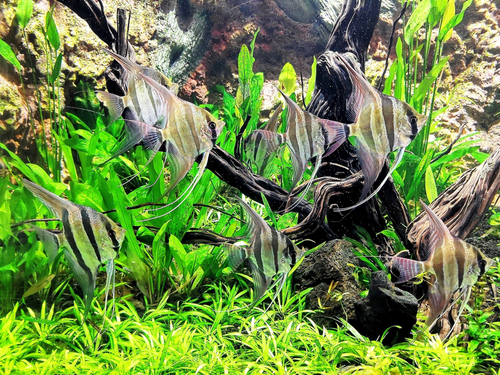
Although the altum angelfish is an intermediate fish to keep, breeding them can be slightly more challenging. This is because as they are wild caught species, they still have very strong instincts. They are marginally more sensitive than their captive counterparts. It’s best to take a hands off approach because these fish prefer to choose their own mates!
1. Breeding In A Separate Tank
If you only want a certain selection of your fish to breed, you can breed in a separate tank. Make sure you have room for this and have set it up so that the environment is as similar to their home tank as possible.
Breeding in a separate tank can be a good idea as when breeding, it’s advised to give your fish a different diet as well as change the water more frequently. A separate tank can prevent these changes from affecting your other fish.
2. Using A Tank Separator
Altermnatively, a tank separator can be added to an existing tank to cut off the breeding pairs from the rest of the tank. This can help them feel less stressed, which encourages breeding.
Either way, you’ll start noticing lots of signs when they are ready to mate, such as changes in their swimming pattern. You will also be able to see a specialised organ, the papilla, near the ventral fin of the female.
You can keep 4-8 pairs set aside to breed and let the fish choose their own partners, which will become obvious as you watch them follow each other around and even lock lips.
3. Breeding Altum Angelfish Tips
When breeding, your fish will need more protein than usual because of the extra energy they are using. Another thing you can do is to feed them little and often (twice as opposed to once a day or even three times). This keeps their energy topped up and means you are more likely to breed them successfully.
When breeding fish it’s always important to ensure you have enough space and don’t overstock. Did you know, tank density can actually affect your fish’s growth, well-being, and survival? This is especially so for hierarchical fish like the angelfish, for whom their surrounding social group is very important. A female fish can produce over 500 eggs, and so you will get a significant amount of fry, even if not all eggs hatch.
Either way, a huge draw to breeding angelfish is that these fish are great parents and it is a delight to see them nurturing their eggs and fry. This guide is by no means exhaustive and there is plenty more you can know about how angelfish mate, however, for an intermediate to advanced aquarist, altum angelfish breeding is a fantastic project.
Author’s Note: breeding time is when your altum angelfish are most likely to be aggressive. This is because they are territorial, and this instinct will be even stronger as fish seek to defend their eggs and split up into breeding pairs. This is why having a large tank with plenty of ‘areas’ separated by rocks, plants, and wood is so helpful.
Final Thoughts
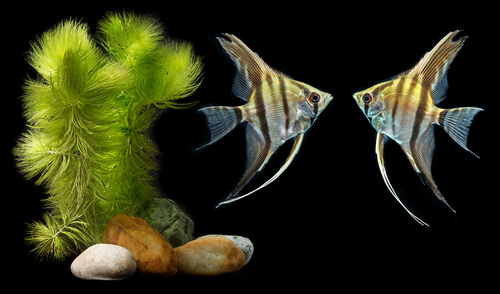
Altum angelfish is a minimalist and natural-looking fish to keep, especially if you want to recreate a river environment in your tank. They have different requirements to captive-bred angelfish like the koi angelfish or pink angelfish, but as a result, they can make an underrated and head-turning pet to care for, especially when you see a whole shoal of them swimming in unison.

